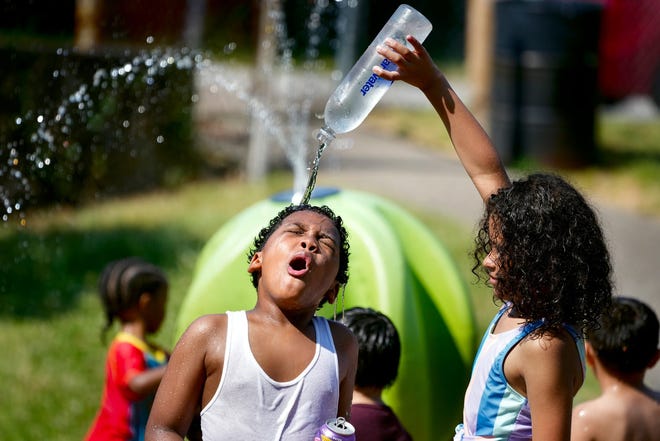A scorching heat wave roasting the country and leading up to the summer solstice was expected to intensify in the coming days, potentially breaking records and impacting more than 135 million people, meteorologists warned Wednesday.
From the Ohio Valley to the mid-Atlantic to New England, temperatures will reach the 90s, and some places could soar to over 100 degrees, according to AccuWeather.
Pockets of the U.S. not accustomed to extreme heat were already feeling the effects Wednesday, such as Caribou, Maine, where records go back to 1939. “The heat index at Caribou currently stands at 103F,” the weather service said in a social media post. “That’s an unofficial all-time record.” The heat index in parts of the state could rise even higher − to 105 − on Thursday, according to the National Weather Service.
Daytime temperatures around Pittsburgh are expected to feel like 110 degrees through Saturday. The heat index in Northwest Ohio and Northern Indiana is expected to reach as high as 102 through Friday. Temperatures in Washington, D.C., could climb to 101 degrees on Sunday.

Overnight low temperatures in the 70s would provide little relief, forecasters said. The National Weather Service warned high humidity will significantly increase the potential for heat-related illnesses, especially for those working outside.
Cities brace for heat:Massive heat wave heading for USA next week. Cities have been preparing for this.
“As high pressure continues to build in the East, the Ohio Valley and Northeast will see daily temperature records challenged on Wednesday and Thursday. High temperatures will be between 90 and 100 degrees Fahrenheit and pose a risk for heat-related illnesses across the region,” AccuWeather Meteorologist Alex Duffus said.
Relief from the heat isn’t expected until the end of the weekend and next week, when a cold front will cool down the Midwest and Northeast, according to AccuWeather.
Unprecedented heat in Maine
Angela LaFlash is a meteorologist at the NWS station in Caribou, Maine, where temperatures have been rising since Tuesday and have reached unprecedented levels.
“My goodness, the amount of heat we’ve had has been unbelievable,” said LaFlash. “Yesterday was the first excessive heat warning we have ever issued in the history of our office, so it’s been toasty.”
An excessive heat warning is issued when the heat index reaches over 105 for two hours or more, according to the weather service in Maine.
The heat is well above average in the region where temperatures are typically in the mid-70s, LaFlash said.
Stephen Baron, a meteorologist at the NWS station in Gray, Maine, which also issued an excessive heat warning, said such heat typically doesn’t hit southern Maine until the dog-days of summer in August.
“It’s considered to be a dangerous heat,” he said. “If you have to be outside, make sure you’re taking breaks and staying hydrated.
LaFlash said a cold front coming down northern Canada would begin cooling the region by Thursday evening and bring possible showers.
Heat not just for the Northeast
The blistering heat won’t only be felt across the Northeast and Midwest: The National Weather Service also has issued excessive heat warnings for much of southern Arizona. Temperatures reached over 102 degrees in Phoenix and Tucson, and are expected to climb as high as 113 on Thursday as dry, hot air continues to dominate the region.
Chris Rasmussen, a meterologist at the NWS station in Tucson said it was the fourth excessive heat warning issued by the office so far this year, but conditions would still be dangerous for locals.
“It’s so commonplace, you tend to kind of neglect what you should do,” said the Tucson native. Any outdoor activities should be done in the morning rather than waiting until the afternoon, he added. “The heat is excessive enough that they should be aware of it and take precautions.”
The excessive heat will help draw in monsoon weather by the evening, Rasmussen said, and Tropical Storm Alberto could push more moisture to the area.
Heat safety tips
The Centers for Disease Control and Prevention, the weather service and other agencies recommend people avoid being outside during the hottest time of the day when heat advisories are in effect. For those without that option, experts suggest working in the shade, taking frequent breaks and drinking plenty of water.
During periods of extreme heat, temperatures inside vehicles can reach deadly temperatures in minutes. People should never leave children or pets inside cars unattended, especially during a heat wave, the weather service said.
Beat the heat: Here’s what a heat wave really is, plus how to keep yourself safe
People at greatest risk are young children, elderly people, outdoor workers and those with chronic diseases, mental illness or take certain medications that make it difficult to regulate their body temperatures, the CDC said. Additionally, those without access to reliable AC are at risk, as are others who live in areas called urban heat islands, with little green space, and are warmer due to more pavement and buildings.
Experts previously told USA TODAY it’s best to check in on those who may be vulnerable with heat.
Contributing: Gabe Hauari, USA TODAY
#Extreme #heat #wave #impacting #Northeast #Midwest #midAtlantic,
#Extreme #heat #wave #impacting #Northeast #Midwest #midAtlantic

